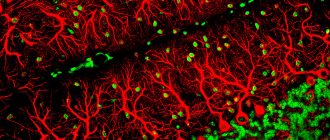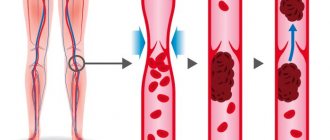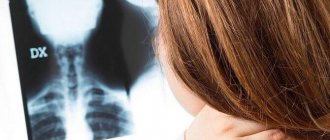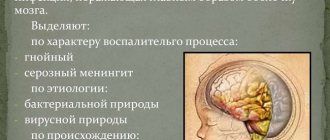Why does damage to the thalamic nuclei lead to a coma?
In principle, it can be argued that the thalamus (or thalamus) is a subcortical center through which all types of sensitivity pass - visual, auditory, skin-kinesthetic, as well as introceptive (sensitivity of receptors located in internal organs). In the thalamus, stimuli from the external and internal environment are integrated, after which they enter the cerebral cortex.
The nuclei of the thalamus are functionally divided into three classes: specific, nonspecific and associative.
- Signals from receptors in the skin, eyes, ear and muscular system go to specific nuclei of the thalamus. The main function of the neurons that make up specific nuclei is to switch information going to the PD cortex from the corresponding receptors.
Local damage to certain specific nuclei leads to loss of the types of sensitivity corresponding to the affected area.
- The associative nuclei of the thalamus are connected, among other things, with the associative zones of the cerebral cortex, which connect newly received sensory information with previously received and stored in memory, and also compare information received from different receptors. Sensory signals are interpreted and used to determine the most appropriate responses, which are selected in the association area and transmitted to its associated motor area.
- The nonspecific nuclei of the thalamus, among other things, are closely connected with many brain systems, incl. with the reticular formation, and play an important role in regulating the processes of neuron activation, regulation of sleep and wakefulness.
Thus, the nuclei of the thalamus are involved in various types of mental activity: all sensory information from the external and internal environment comes here, is integrated and transmitted to higher levels, incl. to the associative, and then to the motor zones of the cortex, which ensures the formation of various motor reactions that are integrated with the vegetative processes that ensure these movements; here, information is exchanged with the energy block of the brain, which regulates the corresponding nervous activity necessary for the execution of motor programs.
Lesions of the thalamic nuclei, caused by mechanical damage or organic pathologies, can disrupt all of the above processes and, depending on the severity, can lead to complete loss of sensitivity and motor activity (coma).
MSD Company and MSD Directories
, Kenilworth, New Jersey, USA (known as MSD outside the US and Canada) is a global healthcare leader working to create a healthier world. From developing new therapeutic methods to treat and prevent disease to helping people in need, we are committed to improving health and well-being around the world. The directory was first published in 1899 as a public initiative. Continuing the legacy of this great resource is the Merck Manual in the United States and Canada and the MSD Manual outside North America. Learn more about our commitment to the Global Health Knowledge Base program.
- About Us
- Legal Disclaimer
- Permission
- Confidentiality
- Terms of Use
- Licensing
- Global Medical Knowledge Base
- Contact us
- Handbook of Veterinary Medicine (English only)
This site complies with the HONcode standard for trustworthy health information: verify here.
Elias A. Giraldo
, MD, MS, California University of Science and Medicine School of Medicine
- 3D model (0)
- Audio (0)
- Side panels (0)
- Video (0)
- Images (3)
- Clinical calculator (0)
- Laboratory research (0)
- Table 2)
Stroke is a heterogeneous group of diseases caused by a sudden focal cessation of cerebral blood flow, which causes the development of neurological disorders. Strokes can be
ischemic (80%), usually as a result of thrombosis or embolism
Temporary stroke symptoms (usually lasting 1 hour) without evidence of acute cerebral infarction (based on diffusion-weighted MRI) are called transient ischemic attack (TIA).
In the United States, stroke is the fifth leading cause of death and the most common cause of neurological disability in adults.
When a stroke occurs, the arteries of the brain are affected (Cerebral arteries) or the anterior vascular system (branches of the internal carotid artery) or the posterior vascular system (branches of the vertebral and basilar arteries).
Arteries of the brain.
The anterior cerebral artery supplies the medial part of the frontal and parietal lobes and the corpus callosum. The middle cerebral artery supplies blood to most of the frontal, parietal and temporal lobes. The branches of the anterior and middle cerebral arteries (lenticulostriate arteries) supply blood to the basal ganglia and the anterior limb of the internal capsule.
The vertebral and basilar arteries supply the brain stem, cerebellum, posterior cerebral cortex, and mediobasal temporal region. The main artery divides into two posterior cerebral arteries to supply blood to the mediobasal regions (including the hippocampus) of the temporal region and occipital lobe of the brain, thalamus, mastoid and geniculate bodies.
The anterior and posterior vascular beds are connected in the circle of Willis.
Cores
The thalamus is part of a complex complex. It is formed from four parts. These include: the hypothalamus, epithalamus, prethalamus, and dorsal thalamus. The last two are derived from the intermediate structure. The epithalamus consists of the pineal thala, triangle and leashes. This area contains the nuclei involved in the activation of the sense of smell. The ontogenetic nature of the epithalamus and perithalamus is different. In this regard, they are considered as separate entities. In general, the structure of the thalamus includes more than 80 nuclei.
Links[edit]
- Harper - Index and search page of the University of Washington faculty web server and search engine + Perseus project tufts.edu Accessed February 9, 2012
- Sherman, S. (2006). "Thalamus". Scholarpedia
.
1
(9): 1583. Bibcode: 2006SchpJ...1.1583S. DOI: 10.4249/scholarpedia.1583. - Sherman, S. Murray; Guillery, R. W. (2000). Study of the thalamus
. Academic press. ISBN 978-0-12-305460-9. - Gorvett, Zaria. "What can be learned from Einstein's bizarre habits". bbc.com
. - Jones, Edward G, ed. (1985). Thalamus - Springer
. DOI: 10.1007/978-1-4615-1749-8. ISBN 978-1-4613-5704-9. S2CID 41337319. - "Medical Definition of NEOTHALAMUS". www.merriam-webster.com
. - "neothalamus | Definition of neothalamus in English by Oxford Dictionaries". Oxford Dictionaries | English
. - Tortora, Gerard; Anagnostakos, Nicholas (1987). Principles of Anatomy and Physiology
(5th Harper International Edition). New York: Harper and Row. paragraph 314. ISBN 978-0060466695. - Jump up
↑ Percheron, G. (1982).
"Arterial blood supply to the thalamus." In Schaltenbrand; Walker, A. E. (ed.). Stereotaxy of the human brain
. Stuttgart: Thieme. pp. 218–32. - Knipe, H Jones, J et al. Thalamus https://radiopaedia.org/articles/thalamus
- Jones Edward G (2007) "The Thalamus" Cambridge University. Click [ page required
] - Jump up
↑ Percheron, G. (2003).
"Thalamus." In Paxinos, G.; May, J. (Ed.). The human nervous system
(2nd ed.). Amsterdam: Elsevier. pp. 592–675. - ^ a b
Carlesimo, Georgia;
Lombardi, M.G.; Caltagirone, C. (2011). "Vascular thalamic amnesia: a reappraisal." Neuropsychology
.
49
(5): 777–89. DOI: 10.1016/j.neuropsychologia.2011.01.026. PMID 21255590. S2CID 22002872. - University of Washington (1991). "Thalamocortical radiations". Washington.edu.
- Gazzaniga; Ivry; Mangun, Michael, S.; Richard B.; George R. (2014). Cognitive neuroscience - biology of the mind
. New York: W.W. Norton. WITH. . ISBN 978-0-393-91348-4 .CS1 maint: multiple names: list of authors (link) - "The thalamus, the brain's messenger, becomes a sensory conduit". University of Chicago Medicine. Retrieved 10 Sep 2021.
- Steriade Mircea; Llinas, Rodolfo R. (1988). "Functional states of the thalamus and associated neural interactions." Physiological Reviews
.
68
(3):649–742. DOI: 10.1152/Physrev.1988.68.3.649. PMID 2839857. - Coma and disorders of consciousness
ISBN 978-1-447-12439-9 page 143 - Neuroscience of Consciousness: Cognitive Neuroscience and Neuropathology
ISBN 978-0-123-74168-4 page 10 - Leonard, Abigail W. (August 17, 2006). "Your brain boots up like a computer". LiveScience
. - Stein, Thor; Moritz, Chad; Quigley, Michelle; Cordes, Dietmar; Haughton, Victor; Meieran, Elizabeth (2000). "Functional connectivity in the thalamus and hippocampus studied using functional MRI". American Journal of Neuroradiology
.
21
(8):1397–401. PMID 11003270. - Aggleton, John P.; Brown, Malcolm W. (1999). "Episodic Memory, Amnesia, and the Hippocampus-Anterior Thalamic Axis" (PDF). Behavioral and Brain Sciences
.
22
(3): 425–44, discussion 444–89. DOI: 10.1017/S0140525X99002034. PMID 11301518. - Aggleton, John P.; O'Mara, Shane M.; Vann, Seralynne D.; Wright, Nick F.; Tsanov, Marian; Eriksen, Jonathan T. (2010). "Hippocampus-anterior thalamic memory pathways: Unraveling a network of direct and indirect actions". European Journal of Neurobiology
.
31
(12):2292–307. DOI: 10.1111/j.1460-9568.2010.07251.x. PMC 2936113. PMID 20550571. - Burgess, Neil; Maguire, Eleanor A; O'Keefe, John (2002). "The human hippocampus and spatial and episodic memory". Neuron
.
35
(4): 625–41. DOI: 10.1016/S0896-6273(02)00830-9. PMID 12194864. S2CID 11989085. - Evarts, E. V.; Thach, W. T. (1969). "Motor mechanisms of the central nervous system: cerebrocerebellar relationships." Annual Review of Physiology
.
31
: 451–98. DOI: 10.1146/annurev.ph.31.030169.002315. PMID 4885774. - Orioli, P.J.; Strick, P.L. (1989). "Cerebellum connections to the motor cortex and arcuate premotor area: analysis using WGA-HRP retrograde transneuronal transport." Journal of Comparative Neuroscience
.
288
(4):612–26. DOI: 10.1002/cne.902880408. PMID 2478593. S2CID 27155579. - Asanuma C, Thach WT, Jones EG (May 1983). "Cytoarchitectonic demarcation of the ventral lateral thalamic area in the monkey". Brain Research
.
286
(3):219–35. DOI: 10.1016/0165-0173 (83) 90014-0. PMID 6850357. S2CID 25013002. - Jump up
↑ Kurata, K (2005).
"Activity properties and locations of neurons in the motor thalamus that project to cortical motor areas in monkeys". Journal of Neurophysiology
.
94
(1):550–66. DOI: 10.1152/jn.01034.2004. PMID 15703228. - https://www.optomotorik.de/blicken/anti-rev.htm [ full link required
] - Kunimatsu, J; Tanaka, M. (2010). "The role of the primate motor thalamus in the generation of antisaccades" (PDF). Journal of Neuroscience
.
30
(14):5108–17. DOI: 10.1523/JNEUROSCI.0406-10.2010. PMC 6632795. PMID 20371831. - ^ a b
"New role discovered for brain region".
Neuroscience News
. 2017-05-03. Retrieved December 3, 2021. - Schmitt, L. Jan; Wimmer, Ralf D.; Nakajima, Miho; Hupp, Michael; Mofaham, Sima; Halassa, Michael M. (May 11, 2021). "Thalamic strengthening of cortical connections supports attentional control". Nature
.
545
(7653):219–223. Bibcode: 2017Natur.545..219S. DOI: 10.1038/nature22073. ISSN 1476-4687. PMC 5570520. PMID 28467827. - Kuhlenbeck, Hartwig (1937). "Ontogenetic development of diencephalic centers in the brain of birds (chickens) and comparison with the diencephalon of reptiles and mammals." Journal of Comparative Neuroscience
.
66
: 23–75. DOI: 10.1002/cne.900660103. S2CID 86730019. - Shimamura, K; Hartigan, DJ; Martinez, S; Puelles, L; Rubinstein, J. L. (1995). "Longitudinal organization of the anterior neural plate and neural tube". Development
.
121
(12):3923–33. PMID 8575293. - ^ a b
Scholpp, Steffen;
Lumsden, Andrew (2010). "Building mating peace: development of the thalamus". Trends in Neuroscience
.
33
(8): 373–80. DOI: 10.1016/j.tins.2010.05.003. PMC 2954313. PMID 20541814. - Hirata, T.; Nakazawa, M; Muraoka, O; Nakayama, R. Suda, Y; Hibi, M. (2006). "Zinc finger genes Fez and Fez-like functions in the establishment of diencephalon subdivisions". Development
.
133
(20):3993–4004. DOI: 10.1242/dev.02585. PMID 16971467. - Jeong, J.-Y.; Einhorn, Z.; Mathur, P.; Chen, L.; Lee, S.; Kawakami, K.; Guo, S. (2007). "Patterning of the zebrafish diencephalon using the conserved zinc finger protein Fezl". Development
.
134
(1):127–36. DOI: 10.1242/dev.02705. PMID 17164418. - Acampora, D; Avantaggiato, V; Tuorto, F; Simeone, A (1997). "Genetic control of brain morphogenesis by Otx gene dosage requirements". Development
.
124
(18):3639–50. PMID 9342056. - Scholpp, S.; Foucher, I.; Staudt, N.; Peukert, D.; Lumsden, A.; Howarth, K. (2007). "Otx1l, Otx2, and Irx1b establish and position ZLI in the diencephalon". Development
.
134
(17):3167–76. DOI: 10.1242/dev.001461. PMC 7116068. PMID 17670791. - Song, Hobeom; Lee, Bamwi; Pyun, Dohun; Guimera, Jordi; Son, Youngsuk; Yoon, Jason; Baek, Kwangi; Wurst, Wolfgang; Jeon, Yongsu (2015-02-15). "Ascl1 and Helt act combinatorially to determine thalamic neuron identity by repressing Dlxs activation". Developmental Biology
.
398
(2):280–291. DOI: 10.1016/j.ydbio.2014.12.003. ISSN 1095-564X. PMID 25512300. - Puelles, L; Rubinstein, J. L. (2003). "Forebrain Gene Expression Domains and the Evolving Prosomeric Model". Trends in Neuroscience
.
26
(9): 469–76. DOI: 10.1016/S0166-2236(03)00234-0. PMID 12948657. S2CID 14658562. - Ishibashi, M; McMahon, A. P. (2002). "A hedgehog-dependent sonic relay regulates the growth of diencephalic and mesencephalic buds in the early mouse embryo." Development
.
129
(20):4807–19. PMID 12361972. - Kicker, C; Lumsden, A (2004). "Hedgehog signaling from ZLI regulates diencephalic regional identity". The Nature of Neuroscience
.
7
(11): 1242–9. DOI: 10.1038/nn1338. PMID 15494730. S2CID 29863625. - Scholpp, S.; Wolf, O; Mark, M; Lumsden, A (2006). "Hedgehog signaling from the zona limitans intrathalamica controls zebrafish diencephalon patterning". Development
.
133
(5):855–64. DOI: 10.1242/dev.02248. PMID 16452095. - Scholpp, S.; Delogu, A.; Gilthorpe, J.; Peukert, D.; Schindler, S.; Lumsden, A. (2009). "Her6 regulates neurogenetic gradient and neuronal identity in the thalamus". Proceedings of the National Academy of Sciences
.
106
(47):19895–900. Bibcode: 2009PNAS..10619895S. DOI: 10.1073/pnas.0910894106. PMC 2775703. PMID 19903880. - Vue, Tou Yia; Blaske, Christa; Alishahi, Amin; Yang, Lin Lin; Koyano-Nakagawa, Naoko; Novich, Bennett; Nakagawa, Yasushi (2009). "Sonic Hedgehog signaling controls thalamic progenitor identity and nuclear specification in mice". Journal of Neuroscience
.
29
(14): 4484–97. DOI: 10.1523/JNEUROSCI.0656-09.2009. PMC 2718849. PMID 19357274. - Young, Keith A.; Holcomb, Leigh A.; Bonkale, Willy L.; Hicks, Paul B.; Yazdani, Umar; Herman, Dwight K. (2007). "5HTTLPR polymorphism and pulvinar enlargement: opening a loophole in the limbic system." Biological Psychiatry
.
61
(6):813–8. DOI: 10.1016/j.biopsych.2006.08.047. PMID 17083920. S2CID 2214561. - Dejerine, J.; Roussy, G. (1906). "Thalamic syndrome". Revue Neurologique
.
14
: 521–32. - Kopelman, MD; Thomson, A.D.; Guerrini, I; Marshall, E. J. (NaN). "Korsakoff's syndrome: clinical aspects, psychology and treatment". Alcohol and Alcoholism (Oxford, Oxfordshire)
.
44
(2): 148–54. DOI: 10.1093/alcalc/agn118. PMID 19151162. Check date values in: |date=(help) - Rahme, R; Moussa, R. Awada, A; Ibrahim, I; Ali, Y; Maarrawi, J; Rizk, T; Nohra, G; Okais, N; Samaha, E (April 2007). "Acute Korsakoff's amnestic syndrome resulting from infarction of the left thalamus after hemorrhage into the right hippocampus." A.J.N.R. American Journal of Neuroradiology
.
28
(4): 759–60. PMID 17416834.
Clinical manifestations
The initial symptoms of a stroke develop suddenly. The most common symptoms of stroke include numbness, weakness or paralysis of the contralateral limbs and half of the face, aphasia, confusion, visual disturbances in one or both eyes (for example, transient blindness in one eye), dizziness or loss of stability and coordination, and headache.
The nature of the neurological symptoms corresponds to the location of the lesion (see table Some Symptoms of Stroke). Stroke of the blood supply to the anterior part of the brain usually causes unilateral symptoms. A stroke in the posterior vascular system can cause unilateral or bilateral disorders, often with impaired consciousness, especially when the basilar artery is affected.
Some symptoms of a stroke
Contralateral hemiparesis (predominantly involving the leg), urinary incontinence, aspontaneity, confusion, impaired logical thinking, mutism, grasp reflex, gait apraxia
Anterior cerebral artery (rare)
Contralateral hemiparesis (with more pronounced involvement of the arm and face compared to the leg), dysarthria, hemianesthesia and homonymous hemianopsia on the opposite side, aphasia (if the dominant hemisphere is affected) or apraxia and half-space neglect (if the non-dominant hemisphere is affected)
Middle cerebral artery (common)
Contralateral homonymous hemianopsia, unilateral cortical blindness, amnesia, unilateral palsy of the third pair of cranial nerves, hemiballismus
Posterior cerebral artery
Unilateral vision loss (amaurosis)
Ophthalmic artery (branch of the internal carotid artery)
Nerve pathways
The thalamus is a formation associated with the hippocampus. The interaction is carried out through a special tract in which the fornix and mastoid bodies are present. The thalamus is connected to the cortex by thalamocortical rays. There is also a path through which information about itching, touch, and temperature is transmitted. It runs in the spinal cord. There are two sections: ventral and lateral. The first carries impulses about pain and temperature, the second - about pressure and touch.










